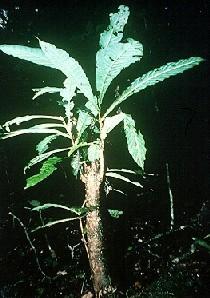Yohimbe
[size=75]From Wikipedia, the free encyclopedia [/size]
?
Yohimbine, also known under the antiquated names “harveys harvest” quebrachin, aphrodin, corynine, yohimvetol and hydroergotocin, is the principal alkaloid of the bark of the West-African evergreen Pausinystalia yohimbe Pierre (formerly Corynanthe yohimbe), family Rubiaceae (Madder family). There are 31 other yohimbane alkaloids found in Yohimbe. In Africa, yohimbine has traditionally been used as an aphrodisiac.[1] However is is very important to note that while the terms yohimbine, yohimbine hydrochloride, and yohimbe bark extract are related, they are not interchangeable.[2] It is important to note the yohimbine, in any form, has not been used medically for penis enlargement.
The NIH states that “Yohimbine hydrochloride is the standardized form of yohimbine that is available as a prescription drug in the United States, and has been shown in human studies to be effective in the treatment of male impotence”.[3] Yohimbine Hydrochloride is a selective competitive alpha2-adrenergic receptor antagonist. The alpha2 receptor is responsible for sensing adrenaline and noradrenaline and telling the body to decrease its production as part of a negative feedback loop.
The active chemical present in yohimbe bark is Yohimbine HCl (indole alkaloid) found in the bark of the Pausinystalia yohimbe tree. Yohimbine hydrochloride is a standardized form of yohimbine that is available as a prescription drug in the United States, and has been shown in human studies to be effective in the treatment of male impotence. Yohimbine hydrochloride has also been used for the treatment of sexual side effects caused by some antidepressants (SSRIs), female hyposexual disorder, as a blood pressure boosting agent in autonomic failure, xerostomia, and as a probe for noradrenergic activity." Even though Yohimbine hydrochloride has been shown in multiple human trials to effectively treat male impotence. The levels of yohimbine that is present in yohimbe bark extract are variable and often very low. Therefore, although yohimbe bark has been used traditionally to reduce male erectile dysfunction, there is not enough scientific evidence to form a firm conclusion in this area." [4]
Yohimbine also antagonizes several serotonin receptor subtypes: 1A (inhibitory, behavioral control), 1B (inhibitory, vasoconstriction), 1D (inhibitory, vasoconstriction), and 2B (smooth muscle contraction). Since yohimbine is an antagonist, it will decrease the effects of these receptors, thus causing excitation, vasodilation, and smooth muscle relaxation. Yohimbine is also said to increase dopamine and have some actions as an MAOI, although these mechanisms are unknown. Higher doses of oral yohimbine may create numerous side effects such as rapid heart rate, high blood pressure, and overstimulation. Yohimbine might produce anxiety, and is thought to cause insomnia and sleeplessness in some users.
Some internet shops sell expensive formulations of yohimbine for transdermal delivery to effect a local reduction of adipose tissue, although there is no evidence that it is effective. Demand for products of this kind is frequently found in the bodybuilding community.
Yohimbine chloride – a standardized form of yohimbine-- is a prescription medicine that has been used to treat erectile dysfunction.[5] Controlled studies suggest that it is not always an effective treatment for impotence, and evidence of increased sex drive (libido) is anecdotal only [7]. It has significant side effects such as anxiety reactions. According to the Mayo Clinic, yohimbine can be dangerous if used in excessive amounts.[6]
It cannot be excluded that orally administered yohimbine can have a beneficial effect in some patients with ED. The conflicting results available may be attributed to differences in drug design, patient selection, and definitions of positive response. However, generally, available results of treatment are not impressive.

